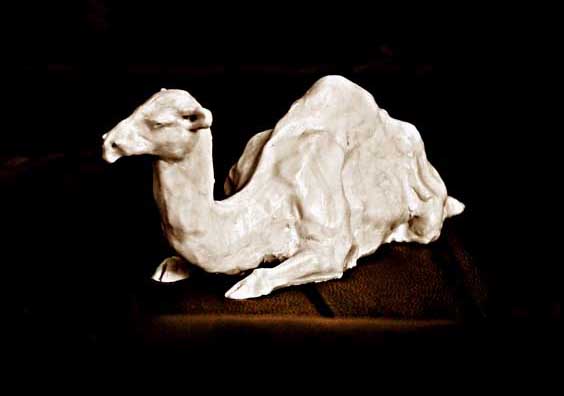Camel Statue

In today's hyper sophisticated world the majority of people are well aware that camels are divided into two basic groups. These are, of course, the one humpers and the two humpers - although true camel cognsocenti prefer the terms dromedary - found in Africa and in southern regions of Asia - and Bactrian who hail from northwest China and southern Mongolia. This sculpture - modeled in polymer clay - is obviously (or hopefully it's obvious) a one-humper - that is, a dromedary.
The virtue of a camel is they are particularly adaptable to harsh environments and over the millennia migrated throughout the globe. Despite their rather cantankerous natures, camels and their relatives - which include the alpacas and llamas of South America - have been domesticated for thousands of years.
However, one place where camel introduction was never successful is, ironically, the region of their biological origins, North America. But it hasn't been for want of trying. In 1855, the American Congress authorized the formation of the United States Camel Corps, a division of the army who was charged with testing the suitability of replacing horses with camels in the American West. The program was overseen by none other than the then Secretary of War, Jefferson Davis, later the first (and last) president of the Confederate States of America. The camel experiment, by the way, was - quote - "immortalized" - unquote - in the 1976 movie "Hawmps!" which boasted of - if nothing else - a couple of first rate supporting actors, Jack Elam and Slim Pickens. It was a movie that was not intended to be taken very seriously, either by the cast, the critics, or the public, which was a good thing.
The official opinion about the effectiveness of the camel was mixed. The beasts were quite good for hauling large amounts of supplies, true, but this was counterbalanced by their proverbial ill tempers (which includes a tendency to spit). And although it is true they can go long distances without drinking water, between those distances they need to wolf down as much as 30 gallons at a sitting. Also the camel's feet are surprisingly tender - fine for walking over sand dunes of the African and Asian deserts, but less suited for the rocky terrain common in the American Southwest. So all in all, there weren't any real advantages for the Arabian ship of the desert, and the army preferred to stick with horses for riding and mules for baggage.
The experiment didn't so much end as peter out. By 1861, Jefferson Davis had resigned his membership in the US Senate, and the Union and Confederate administrations had more things to worry than what to do with the camels. The oft heard story is the camels were just turned loose to roam at will. Actually, though, many were sold to zoos, circuses, or just curious ranchers. But a number did escape, and in North America the last reported sightings (note plural and qualification) of feral camels was in the mid-20th century.
A similar experiment fared better - nominally at least - in Australia where camels were imported from Asia as beasts of travel and transport. There they adapted well, possibly because the terrain was more similar to that of Africa and Asia than that of North America. But if you lived in the late nineteenth century motorized transport was looming in your future and soon there was no need for camels as beasts of burden. But unlike their counterparts in North America, those that escaped thrived. By the early 1960's the camel population reached about a million - yes, that's a million - and most of them roaming in the central outback. They did so well that there was a concern that they were wreaking serious havoc on the desert ecosystems and the agricultural and ranching industries. I mean if rabbits could destroy the landscape imagine what equal numbers of massive even toed ungulates could do. However, today there are now "only" about 750,000 animals, and the situation is considered in control - at least to some degree.
You will read on the Fount of All Knowledge (the Internet) that today Australia has the largest population of camels. Even at their peak that wasn't true. But the Aussies do have the largest population of feral - that is wild - camels in the world. But if you're talking about places with the most camels, you need to turn to countries in Africa and to Saudi Arabia where the combined camels number upwards of 15 million. Most of these, though, are domesticated.